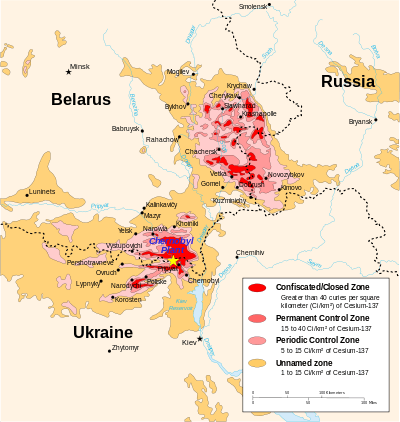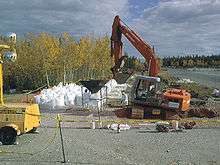Radioecology
_and_the_nuclear_power_plant_cooling_tower_in_Doel%2C_Belgium_(DSCF3859).jpg)
Radioecology is the branch of ecology concerning the presence of radioactivity in Earth’s ecosystems. Investigations in radioecology include field sampling, experimental field and laboratory procedures, and the development of environmentally predictive simulation models, all in an attempt to understand the migration methods of radioactive material throughout the environment.
The practice consists of techniques from the general sciences of physics, chemistry, mathematics, biology, and ecology, coupled with applications in radiation protection. Radioecological studies provide the necessary data for dose estimation and risk assessment regarding radioactive pollution and its effects on human and environmental health.[1]
Radioecology strives to detect and evaluate the effects of ionizing radiation and radionuclides on ecosystems, and then assess their risks and dangers. The study is primarily European by origin,[2] intended to ascertain and manage the risks involved as a result of the Chernobyl disaster. The practice of radioecology is vitally important for the preservation of the environment considering the recent boom in nuclear energy production.
History
Artificial radioactive affliction to Earth’s environment began with nuclear weapon testing during World War II, but did not really come to the forefront of public discussion until the 1980s. In fact, the Journal of Environmental Radioactivity (JER) has only existed since 1984.[3] As demand for construction of nuclear power plants increased, it became necessary for humankind to understand how radioactive material interacts with various ecosystems in order to prevent or minimize potential damage. The aftermath of Chernobyl was the first major employment of radioecological techniques to combat radioactive pollution from a nuclear power plant[4] · .[5]

Collection of radioecological data from the Chernobyl disaster was performed on an individual basis. Independent scientists or universities were the ones conducting experiments rather than the governments of the affected countries. A collective experimental effort from a conglomeration of governments may have been more trustworthy, but the results from the individuals was nevertheless useful and interesting. Data[6] was gathered considering the various dosage levels and geographical differences among the afflicted areas, and the independent researchers were able to draw conclusions for the nature and intensity of the damage to ecosystems caused by this disaster.
These local studies were the best available resources in containing the effects of Chernobyl. However, the researchers themselves recommended that a more cohesive effort between the neighboring countries be used to better anticipate and control future radioecological issues, especially considering the ongoing terrorism threats and the potential use of a "dirty bomb".[7] Japan faced similar issues when the Fukushima Daiichi nuclear disaster occurred, as its government also struggled to organize collective research efforts.
An international radioecology conference was held for the first time in 2007 in Bergen, Norway.[8] European scientists from various countries had pushed for joint efforts[9] to combat radioactivity in the environment for three decades, but governments were hesitant to attempt this feat because of the secrecy involved in nuclear research, as technological and military developments remained competitive.
Objective
The aims of radioecology are to determine the concentrations of radionuclides in the environment, to understand their methods of introduction, and to outline their mechanisms of transfer within and between ecosystems. Radioecologists evaluate the effects of both natural and artificial radioactivity on the environment itself as well as dosimetrically on the human body. Radionuclides transfer between all of Earth’s various biomes so radioecological studies are organized within three major subdivisions of the biosphere, namely land environments, oceanic aquatic environments, and non-oceanic aquatic environments.[10]
Scientific Background
Nuclear radiation is harmful to the environment over immediate (seconds or fractions thereof) as well as long-term (years or centuries) timescales, and it affects the environment on both microscopic (DNA) and macroscopic (population) levels. Effects are also subject to magnification and demagnification from external factors, especially in the case of humans.
This discipline is therefore interested in all interactions that affect biological and geological material as well as the interactions between different forms of matter (solid, liquid, gaseous), as each can carry radionuclides.
The origin of radioactivity is sometimes nature itself, as geological sites are sometimes known to be rich in radioactive uranium or produce radon emissions, but the largest culprit is certainly artificial pollution via nuclear meltdowns or expulsion of radioactive waste from industrial plants. Additionally, the ecosystems at risk may also be fully or partially natural. An example of a fully natural ecosystem might be a meadow or old-growth forest affected by fallout from a nuclear accident such as Chernobyl or Fukushima, while a semi-natural ecosystem might be a secondary forest, farm,[11] reservoir, or fishery that is at risk of infection from some source of radionuclides.
Basic herbaceous or bivalve species such as mosses, lichens, clams, and mussels are often the first organisms affected by fallout in an ecosystem,[12] as they are in closest proximity to the abiotic sources of radionuclides (atmospheric, geological, or aquatic transfer). This results in these organisms often possessing the highest measurable concentrations of radionuclides, making them ideal bioindicators for sampling radioactivity in an ecosystem and comparing with others. Often the ecologist must - in the absence of sufficient data - rely on analogs of a radionuclide to attempt to evaluate (or hypothesize about) certain ecotoxicological, metabolic effects of elusive or little-known radionuclides.
A radioecologist relies on the tools of ecology, which includes methods of physics, chemistry, mathematics, biology, and modeling, specifically the methods that pertain to radionuclides, bioelectromagnetism, bioelectrochemistry, electromagnetic pollution, and isotope analysis.
Radioecological Threats
Concentrations of artificial radionuclides throughout the biosphere are on the rise. Radioactivity originating from the Northern Hemisphere[13] is observable dating back to the mid-20th century. Some highly toxic radionuclides have particularly long radioactive half-lives (up to as many as millions of years in some cases[3]), meaning they will virtually never disappear on their own. To make matters more difficult, the impact of these radionuclides on biological material (correlated with their radioactivity and toxicity) is similar to that of other environmental toxins, making them difficult to trace within plants and animals.[3]
In addition, Earth in the 21st century is at risk of the accumulation of nuclear waste as well as the potentiality of nuclear terrorism, which could both lead to leaks, making the further radioactive pollution of Earth seem almost inevitable.

Some aging nuclear facilities were not intended to run as long as they have, and the consequences of their intended waste procedures were not well understood when they were built. One example of this is how the radionuclide tritium is sometimes released into the surrounding environment as a result of nuclear reprocessing, as this was not a foreseen complication in the original waste management orders of operations. It is difficult to diverge from these procedures once a reactor has already been put to use, since any change either risks releasing even more radioactive material or jeopardizes the safety of the individuals working on the disposal. Protection of human well-being has been, and remains to this day, paramount in the aims of radioecological research and risk assessment.
This philosophy does not bode well for the environment, as radioecology often calls into question the ethics of protecting human health versus the preservation of the environment in the interest of fighting extinction of other species,[14] but public opinion on this matter is shifting.[15] Radioecology endures many tough moral questions, namely difficulties in weighing the effects of varying doses of radiation on topics such as speciation.[16] Nevertheless, research is ongoing and public interest in any field always scales with its relevance to current events.
See also
References
- ↑ IFE - Radioecology
- ↑ J. Van Den Hoek (1988)European research on the transfer of radionuclides to animals — A historical perspective ; Pages 17-27 (abstract)
- 1 2 3 S.C. Sheppard, An index of radioecology, what has been important ? ; Journal of Environmental Radioactivity, Volume 68, Issue 1, 2003, Pages 1-10.
- ↑ J. Hilton, Aquatic radioecology post Chernobyl—a review of the past and a look to the future ; Studies in Environmental Science, Volume 68, 1997, Pages 47-73
- ↑ Sir Frederick Warner (Editor), Roy M. Harrison (Editor), Radioecology After Chernobyl: Biogeochemical Pathways of Artificial Radionuclides (SCOPE Series)
- ↑ 3.1.5. Deposition of radionuclides on soil surfaces (PDF). Environmental Consequences of the Chernobyl Accident and their Remediation: Twenty Years of Experience, Report of the Chernobyl Forum Expert Group ‘Environment’. Vienna: International Atomic Energy Agency (IAEA). 2006. pp. 23–25. ISBN 92-0-114705-8. Retrieved 12 September 2013.
- ↑ MØLLER Anders et MOUSSEAU Timothy A. (2006), Biological consequences of Chernobyl : 20 years on ; Revue : Trends in ecology & evolution, vol. 21, n°4, pp. 200-207 ; 8 pp et 70 ref. ; ISSN 0169-5347 ([abstract Inist/CNRS])
- ↑ 1st International Conference on Radioecology and Environmental Radioactivity 15–20 June 2008, Bergen, Norway ; Journal of Environmental Radioactivity, Volume 97, Issue 1, September 2007, Pages 83-84
- ↑ Commission of the european communities international symposium on radioecology applied to the protection of man and his environment : Rome, 7–10 September 1971 Conference Hall of FAO, Viale delle Terme di Caracalla Water Research, Volume 5, Issue 6, June 1971, Pages 367-368
- ↑ Radioecology: To understand the evolution of radioactivity in the environment, IRSN Corporate Publications: IRSN's thematic booklets, 2001, Page 2
- ↑ R.W. Mayes (1989), The quantification of dietary intake, digestion and metabolism in farm livestock and its relevance to the study of radionuclide uptake ; in Transfer of Radionuclides to Livestock (Oxford, 5–8 September 1988) ; Science of the Total Environment ; Vol 85, September 1989 ; (abstract)
- ↑ D. Jackson, A.D. Smith (1989) Uptake and retention of strontium, iodine and caesium in lowland pasture following continuous or short-term deposition ; Pages 63-72, in Transfer of Radionuclides to Livestock (Oxford, 5–8 September 1988) ; Science of the Total Environment ; Vol 85, September 1989 (abstract)
- ↑ Bennett, A. Bouville, Radiation doses in countries of the northern hemisphere from the chernobyl nuclear reactor accident ; Environment International, Volume 14, Issue 2, 1988, Pages 75-82 B.G.
- ↑ R.J. Pentreath, Radioecology, radiobiology, and radiological protection: frameworks and fractures ; Journal of Environmental Radioactivity, Volume 100, Issue 12, December 2009, Pages 1019-1026
- ↑ Antoine Debauche, Continuous radioactivity monitoring systems. From the pre-history of radioprotection to the future of radioecology ; Journal of Environmental Radioactivity, Volume 72, Issues 1-2, 2004, Pages 103-108
- ↑ J. Butcher, Elemental speciation, Practicalities and InstrumentationEncyclopedia of Analytical Science (Second Edition), 2005, Pages 488-494D.
Further reading
- Eric Hall (2006), Radiobiology for the Radiobiologist, Lippincott.
- Whicker and Schultz (1982), Radioecology.